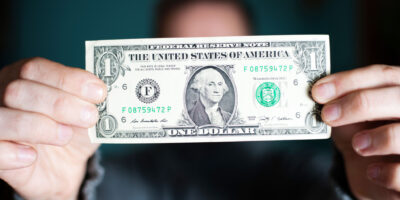In Praise of the $1 Bill
Coinage is a topic that touches all our lives. Some of us use coins every day, others just a few times a month. Even if some of us have gone digital and never pay or receive coins, we probably have a few pennies or nickels tucked away in a box somewhere.
Last month the Government Accountability Office (GAO), a government agency that audits federal government programs, issued a report on U.S. coinage.
The GAO’s report can be broken down into three recommendations:
- It argued against switching from a $1 note with a $1 coin.
- It suggested a slight alteration to the metal composition of the nickel.
- Lastly, it kiboshed the idea of removing the penny.
I’ll deal with the first point in today’s post, and the other two in a follow-up article.
Swapping the $1 note with a $1 coin
Over the last 30 years, Australia, Canada, New Zealand, the U.K., the EU, and Switzerland have all converted their $1 notes (or the nearest equivalent franc or euro note) into coin form. The motivation has been to lower costs.
In a series of reports going back to the 1990s, the GAO has been recommending that the Federal Reserve follow this trend and issue $1 coins instead of $1 notes. But in its most recent report, the GAO reversed its long-held stance in favor of the status quo.
The GAO’s reversal is a wise move: the U.S. is better off with a $1 note. The GAO’s support for the $1 coin has always been faulty. In running its cost-benefit analysis, it never bothered to take the consumer experience into account. When people are given a choice between notes and coins, they will invariably choose the note. Let’s face it: coins are a nuisance.
The proof? Despite having the option of using a $1 coin, Americans almost exclusively rely on the $1 note. As a result, huge amounts of unwanted $1 coins have accumulated in Federal Reserve vaults. A policy that forces Americans to give up the monetary instrument they prefer hardly seems like an improvement.
Over the years, the GAO has also made the mistake of counting seigniorage as a benefit. Coins are heavy and tend to get forgotten in drawers or fall in the cracks of sofas, whereas notes are slim and easy to keep track of. So if a switch were mandated, each $1 note Americans give up would be replaced by one and a half $1 coins to keep the same amount of currency in circulation. In economics lingo, this is called the replacement ratio. When Canada replaced its $1 notes back in the late 1980s, the replacement ratio for the first 10 years after issuance was about 2 to 1, although it later fell to 1.25 to 1.
The government earns a profit (or seigniorage) off of each dollar it issues because currency amounts to an interest-free loan to the government. If coins replace notes, seigniorage will increase because the public holds more coins than notes. This extra seigniorage has motivated the GAO to keep suggesting a switch to coins.
The extra profit the government would earn by switching to $1 coins certainly benefits the government. But it doesn’t help the public. After all, it is really just an extra tax. The net benefit to society is zero, so seigniorage shouldn’t count in a calculation of social welfare. Unfortunately, the GAO has never recognized this point.
In its 2019 report, the GAO has still not given up on its erroneous seigniorage argument. However, another development has tipped the GAO’s findings in favor of the $1 note: improvements in banknote technology.
In general, coins are more costly to produce than notes. But banknotes are less durable and need to be replaced more often. Denominations that circulate the quickest tend to be more prone to deterioration. That’s why small denominations like 25 cents or $1 tend to be represented by coins whereas $50 and $100 denominations (which move much slower) are represented by notes.
Technological improvements have increased the life span of banknotes. In the early 2000s, for instance, the Fed installed new optical sensors that could do a better job of determining whether a used banknote was fit to be put back into circulation. These machines could tell whether a note was torn or folded, the folded one being recirculated rather than withdrawn and destroyed.
This new note sorting technology had a weakness. When a note was misfaced — that is, stacked in such a way that the machine processed it reverse side up rather than portrait side up, it would automatically be destroyed. Later on, new sensor technology allowed for the processing of misfaced notes. According to the Federal Reserve, fixing the problem of misfaced notes increased the $1 bill’s life from 2.5 years in 2006 to 5.9 years by 2012.
Costs and benefits of replacing the $1 Federal Reserve note with a $1 coin
This increase in the life span of notes makes them a better candidate for serving as the face for the lowest monetary denominations. The Fed estimates that the exact tipping point in favor of the $1 banknote occurs at 4.75 years. If a note’s average life is less than that, then it is cheaper to use a $1 coin. Otherwise the bill is superior.
Given this 4.75-year tipping point, the GAO’s historical preference for the $1 coin may have made sense two decades ago. But the lifespan of U.S. banknotes currently clocks in at 7.9 years. It just isn’t very cost effective for the government to replace the $1 coin. It’s good to see the GAO recognizes this and is now advocating the best course of action.
The next step would be to completely discontinue the $1 coin and melt them all down, as I suggested in an earlier article. Maybe that’ll be in the next GAO report on currency.












